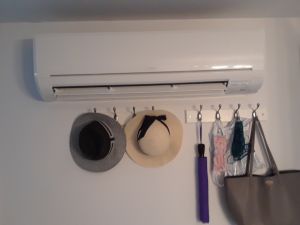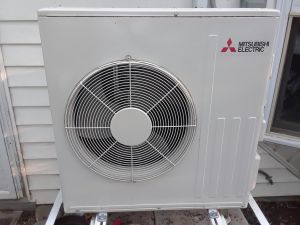_______________________________________________________________________________________________________________________

A head for the heat pump. This 24,000 BTU head comfortably heats and cools the lower 1600 square foot duplex downstairs.

The actual heat pump outside. Not even noticeable if put in a discreet protected location.
________________________________________________________________________________
(Air Source Heat Pumps- will be referred to as heat pumps throughout the rest of the article.)
We heat and cool our 2800 sq. foot house with air source heat pumps, and last year the entire cost for heating and cooling was $1200.00! Love them!
There are two choices to make with air source heat pumps.If you have a ducted system for heating, you can use the heat pumps as a furnace. A ductless heat pump is an option if there are no ducts.
How do they work? During the cooler months, you put the heat pump on heat which then collects the ambient heat in the air outside and blows it into your house by either a furnace setup or a ductless setup. In the summer, you change the setting to air conditioning instead.
One of my favourite features of the heat pump is it can become a dehumidifier which I often use instead of air conditioning. Also, using the fan to distribute fresh air is a great option. I have found the house's air quality to be fresher due to using the ductless heat pumps.
The heat pumps come in different sizes with different BTUs. (British thermal units). A qualified heating and cooling professional will be able to determine the BTUs for your house or apartment. Heat pumps are measured in tons; one ton equals 12,000 BTUs.
There are various sizes and brands of heat pumps. The most important part for us was their performance in cold weather. So we chose the Mitsubishi ductless system with the -25C option, and we have not regretted it! Yes, this brand is more expensive, but they have a ten-year replacement guarantee and they are extremely efficient and designed for cold climates.
Okay, so let's discuss what type ductless or ducted?
As we went with the ductless system, I do not have firsthand knowledge of the furnace heat pump systems, but my understanding is they work just as well as the ductless system or any other type of furnace. Our house has a ducted system, but we decided to go ductless. The reason was not financial but practical. The house is a raised bungalow and has a lower duplex partially in the earth with a separate entrance. The lower duplex's environmental needs are entirely different from the needs of the upper duplex. The lower duplex is north-facing and does not need air conditioning but does get damp, so the dehumidifier option works excellent in this case. A bonus is that the tenant downstairs can adjust the heat or cooling to their comfort levels. In contrast, the upper duplex faces south and gets hotter and requires air conditioning. For these reasons, we opted for two ductless systems, one up and one downstairs.
The lower duplex has an open concept, so one two-ton unit called a head is enough to heat the 1600 square foot space. However, it does get cooler further away from the heating head, so when the temperatures dip below minus -20C, the tenant will use a space heater for a few days.
The upper duplex is a different configuration it is 60 feet long by 25 feet wide, and smaller than the lower duplex but we used a two-ton for that space as well. We decided on two heads, one in the main living room that pushes the heat down the hall to the bedrooms. This head or unit is 18,000 BTUs or one and a half-ton. We decided to add another head of 6000 BTUs in the last bedroom. You can add as many heads or units as you wish; you need to work with the heat pumps available sizes. You can do various breakdowns. Let's use a 24,000 BTU example
· divide 24,000 BTUs into two heads, each 12,000 BTUs
· divide 24,000 into two heads, one 18,000 and one 6000
divide 24,000 into four heads each 6,000 Btus
Do keep in mind each head has a cost.
Okay, cost to install. There are some factors to consider
· How many heads do you need installed?
· Size of heat pump required
· Running the electrical lines
· Running the refrigerant lines from the heat pump unit, so distance matters
It cost us 6500.00 for the unit downstairs and $9000.00 for upstairs because we had two heads installed, one at one end of the sixty-foot house and one at the other end. (we got a rebate from the government of $2000.00)
So here is the good part! We heated and cooled our home with the heat pumps on both floors for $1200.00 last year. Yep, that is right, and that is considering we pay 1/3rd more in hydro because we are rural and pay an additional hefty delivery fee.Our hydro comes from the local Trent River hydro system and does not require shipping over long distances as with gas, propane and oil. The hydro infrastructure has been in place for many years. So it makes sense for the people in the area to use this source of power. As a rule, air-source heat pumps have a low environmental impact overall.
People have asked if I am concerned my heating system is electric and therefore subject to arbitrary cost increases and being out of power. Most of our heating furnaces or plans don't work when the hydro goes, so I do not see any difference. As per cost, gas, propane, and oil are not renewable, and the prices will go up as the supplies dwindle.
To be fully transparent, we use our fireplace upstairs and a pellet stove downstairs occasionally only when the temperatures are in the -15C and below. It is not necessary, but we like the heat. This additional heating cost for the year was $300.00.
Professional maintenance is every two years, so it is cheaper than the yearly furnace maintenance cost. Just as with a furnace, you need to clean the filters in the heads every month or two. It is easy and fast, and you can do it yourself.
Did I mention the pumps are whisper quiet as well?
As I said love them!
Wendy Murdoch
________________________________________________________________________________




